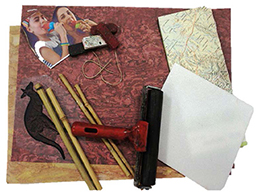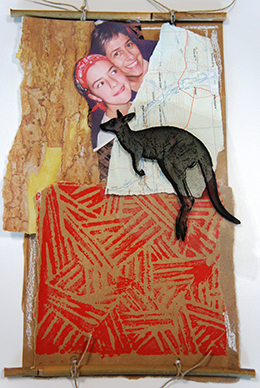This activity was inspired by the exhibition Old Masters: Australia’s Great Bark Artists which featured bark paintings from the National Museum’s collection, painted by Aboriginal artists from Arnhem Land in northern Australia.
Did you know ...
These amazing bark paintings show sacred meanings, traditional knowledge, symbols, history and stories. They are works that are very personal and important to the artist, their families and communities. The colours and patterns have different meanings depending on where the artist is from.
The works are painted to pass on these stories to the next generation or to share with other people outside the family. These artworks are very important and are treasured possessions.
How to make your own story collage

Your collage masterpiece can document your journeys, history and family stories.
Skill level: ★★ Medium – you may need an adult to help
Time: 40–60 minutes
Ages: 5 years and up
What you need:
These materials are only suggestions. You can choose anything from around the house that helps to tell your stories.
- brown card (approximately 160 x 280 mm)
- two sticks about the same length as the shorter edge of your card
- string
- hole punch
- textured, patterned or coloured paper. We used paper that looked like bark but you can use any type of paper
- glue or double-sided tape
- maps or postcards – use these to represent journeys or landscapes of where you are from, or where you have travelled
- photos or photocopied images of your family, friends, pets, home or things that are important to you
- coloured wax crayons. We used red, black, white and yellow but you can use any colour that might be meaningful to you
- printing materials such as foam, roller and paints. Hint: you don’t have to use foam – you can use anything that you can groove a pattern into. Half a potato will work just as well.
Traditionally bark paintings were made from a strip of bark from a stringybark tree. Some have an elongated rectangle shape. We made our collage in a similar rectangular shape. We ripped the edges of our paper instead of cutting it with scissors, to give a rougher edge, similar to the barks.
Questions to start you thinking
- What are the stories of your family?
- What is important to you?
- Do you have any family traditions or symbols?
- If you could make up your own family symbol, what would it look like?
- Where have you come from and where have you travelled?
- Do you have pets or special connections to particular animals?
- When you are older, what do you want your children and grandchildren to remember about you and the times when you lived?
Steps 1–2
- Using a hole punch, put two holes in the shorter edges of the brown card.
- Tie the two sticks at the top and the bottom of the card with the string. This will create a nice frame for your work and make it look special.
- After thinking about the questions above, gather all your photos and images, maps and textured paper. Arrange how you would like to place them on the card. You may need to rip paper and maps to a size that will fit on the cardboard.
- Once you have arranged the paper and photos, glue them on the backing card. You might like to use crayons over the top to add your travels or symbols.
Steps 3–4
- Do you want to add printing to your artwork? Patterns are used a lot in the paintings on show in Old Masters. These patterns have deep spiritual meanings, so it is important not to copy their patterns. Can you come up with your own patterns or symbols?
- Perhaps your family loves to go to the beach, so a pattern of waves or sand might be a good representation.
- In our example, this pattern represents the paving in the family yard, where lots of time was spent playing as kids.
Steps 5–6
